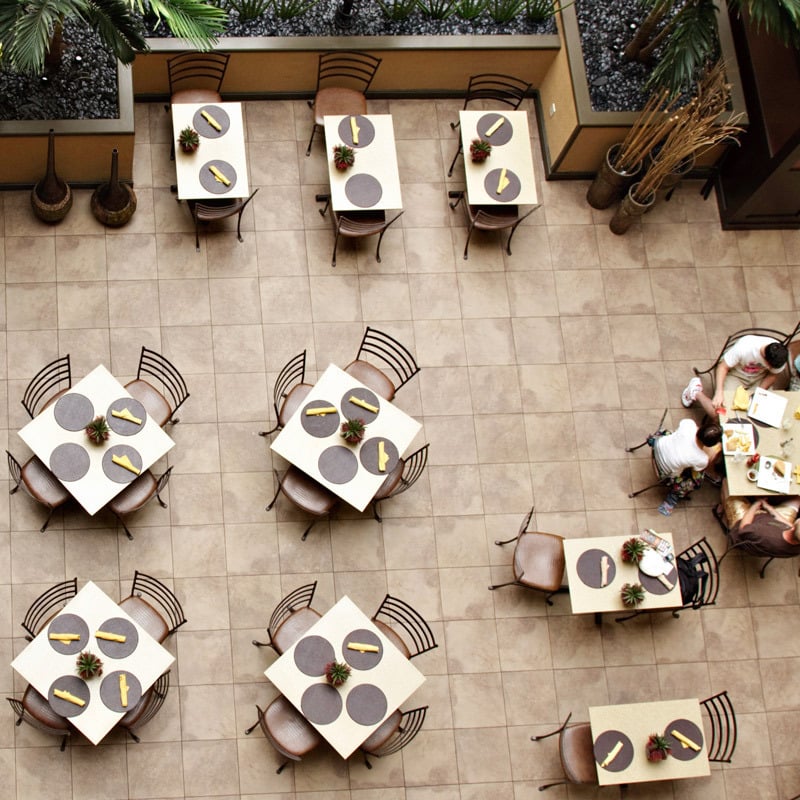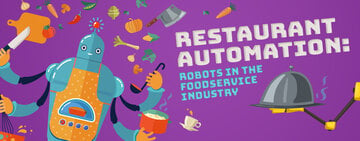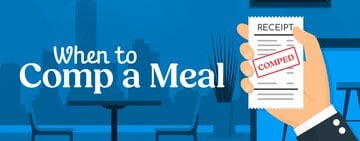
Efficient table turnover is essential for increasing restaurant profit margin and creating a seamless dining experience. While it's crucial to seat as many customers as possible, you also want to make sure each guest feels valued and doesn't feel rushed. Use our guide to restaurant table turnover to maximize profits without coming across as inhospitable.
What Is Table Turnover Rate?

Table turnover rate refers to the number of times a table is occupied by different groups of customers within a specific period, usually measured in hours. The faster a restaurant can turn over its tables, the more customers it can serve, leading to increased revenue. To calculate the table turnover rate, divide the total number of tables turned over during a given period by the number of hours in that period. For example, if a restaurant turns over 50 tables in 4 hours, the table turnover rate would be 12.5 tables per hour. Refer to the formula below to calculate your restaurant table turnover rate.
Table Turnover Rate Formula: # Of Tables Served in Designated Time Frame/# Of Hours = Table Turnover Rate
What Is Seat Turnover Rate?
Seat turnover rate is a metric that calculates the number of times each seat at your restaurant is occupied during a given period. It provides valuable insights into how efficiently you are using your seating capacity and can help you identify opportunities to improve your restaurant's table turnover rate. To calculate the seat turnover rate, you divide the number of customers served in a given period by the number of seats available in your restaurant. A higher seat turnover rate indicates that your seats are consistently occupied, which means you are maximizing your seating capacity and serving more customers. On the other hand, a lower seat turnover rate suggests that you are not filling all the available seats, potentially leaving money on the table. Refer to the formula below to calculate your seat turnover rate.
Seat Turnover Rate Formula: # Of Customers Served in Designated Time Frame/# Of Seats Available = Seat Turnover Rate
How to Increase Table Turnover Rate
Increasing the table turnover rate is crucial for maximizing profits in a restaurant. To achieve this, several strategies can be implemented. Apply the following strategies to increase the table turnover rate at your restaurant.
1. Organize Your Seating System
One way to maximize table turnover is to have an organized seating and reservation system. For this to happen, there must be great communication between servers and hosts. As soon as a server collects the check and signals the busser to start clearing off tables, they should alert the hosts that their table will be open soon. This allows the host to gather the next party in line and have them ready to be seated immediately. The sooner hosts can get customers to their tables, the less time those tables will sit empty. To help improve your seating system and get customers seated faster, follow the tips below.
- Pre-assign Tables: If you have tables pre-assigned to guests waiting in line, host staff can seat guests as soon as their table opens up.
- Create a Waiting Area: Have a waiting area near the host or hostess stand, so hosts can easily find customers as soon as they’re ready to be seated. There’s nothing worse than calling a party’s name multiple times, just to find they’re waiting outside.
- Don’t Accept Reservations: Digital wait lists and reservations can be powerful tools for increasing table turnover. However, if don't have the budget to integrate them, you may do better to forgo reservations. By only accepting walk-in customers you avoid having to deal with parties who made reservations and then are no-shows.
2. Train Your Serving Staff

Staff efficiency is one of the most important factors in maximizing restaurant table turnover. By properly training your servers and bussers, you can ensure that your guests have a smooth and timely dining experience. Here are some key strategies to implement.
- Promptly Greet and Engage Guests: Require servers to arrive at their tables within the first minute guests are seated. By not delaying this first interaction, it expedites the dining experience. Since this initial greeting sets the tone for the entire dining experience, servers should approach guests with a friendly smile, introduce themselves, and make them feel welcome.
- Take Drink Orders Immediately: As soon as guests are seated, servers should ask for their drink orders. Promptly bringing out water or other beverages ensures they do not leave guests waiting and they can start enjoying their meal.
- Provide Menu Highlights: Ask guests if they've dined at the restaurant before. If not, go over some menu highlights to help them make informed choices. This helps customers make ordering decisions faster.
- Share Current Menu Specials: For returning customers, servers can dive into the specials of the day. This can be done verbally or by providing a separate menu that shares the specials. By keeping guests informed about unique and limited-time offerings, you can help customers make a decision.
- Assign Multiple Servers for Large Parties: If you seat a large party, consider having more than one server assigned to the table. Multiple servers can take orders simultaneously and deliver food faster.
- Clear Plates During Service: Instead of waiting until guests have left, instruct your staff to clear off plates as guests finish their meals. This proactive approach helps maintain a clean and organized dining area and allows new guests to be seated promptly.
- Assign Multiple Bussers per Table: To ensure quick turnaround, assign more than one busser per table. Together, they can efficiently clear the remaining dishes and reset the table for the next guests. By having a dedicated busser for each table, the process becomes faster and more streamlined.
- Drop off the Check before Asked: To avoid guests having to wait and flag down a server for the check, train your staff to drop off the check before customers ask for it. By placing the check on the table as guests are finishing up their dessert, they can leave at their convenience.
How Many Tables Should a Server Have at Once?
On average, servers typically handle four to five tables simultaneously. This allows them to provide efficient and attentive service while ensuring an enjoyable experience for all customers.
3. Integrate Technology
In today's fast-paced restaurant industry, integrating technology into your operations is crucial to improving efficiency and maximizing table turnover. By leveraging the power of technology, you can streamline various processes and enhance the overall dining experience for your customers. Here are some steps to help you integrate technology into your restaurant and expedite table turnover times.
- Implement a Mobile POS System: One of the most effective ways to speed up table turnover is by using a mobile point-of-sale (POS) system. With a mobile POS, your staff can take orders and process payments right at the table, eliminating the need for customers to wait in line at a traditional cash register. This not only saves time but also allows your staff to provide more personalized service, ensuring a seamless dining experience.
- Enable Contactless Dining with QR Codes: By implementing QR codes at each table, you can provide customers with digital menus that they can access using their smartphones. This eliminates the need for physical menus, reducing the risk of cross-contamination and saving time for both customers and staff. Additionally, you can use QR codes to offer contactless payment options, further enhancing the efficiency of the payment process.
- Use Digital Reservations and Waitlist Systems: To effectively manage table turnover, it is essential to have a robust reservation and waitlist system in place. By implementing a digital system, customers can easily make reservations online, reducing the time spent on phone calls and manual bookings. A digital waitlist system allows you to manage customer queues and notify them when their table is ready, minimizing wait times and improving overall customer satisfaction.
- Offer Online Ordering: While often associated with takeout and delivery, online ordering can help with table turnover for dine-in guests as well. By integrating an online ordering system into your restaurant's website or mobile app, you can allow customers to place their orders before their arrival, reducing wait times and expediting table turnover.
- Leverage Data for Optimization: Technology provides you with a wealth of data you can leverage to optimize your restaurant's operations. By analyzing customer preferences, order patterns, and peak hours, you can make data-driven decisions to improve your table turnover times. Data analysis can help you identify bottlenecks in your processes and implement strategies to overcome them, ultimately improving overall efficiency.
4. Update Your Dining Room

Updating your restaurant design can make a significant difference in increasing the table turnover in your restaurant. By strategically placing tables and chairs, choosing the right furniture, and incorporating certain colors, you can encourage customers to eat more quickly and increase your table turnover rates. These simple adjustments can impact your restaurant's overall efficiency and profitability.
- Table and Chair Placement: Placing tables and chairs in the center of the dining room, away from corners and walls, encourages customers to eat more quickly. The middle of the room is often the busiest spot in the restaurant, so guests will naturally eat faster. By rearranging your restaurant, you can provide efficient service and faster turnover.
- Types of Seating: Patrons linger longer if they're seated on furniture that's anchored to the ground, like booths. To encourage faster turnover, consider seating small parties at smaller tables and chairs rather than in booths. This allows for easier maneuverability and encourages customers to eat more quickly since they aren't settled into a cozy space.
- Color Psychology: Bright colors, such as red, yellow, orange, and green, raise our heart rates and blood pressure. This excites people and subconsciously encourages them to eat faster, resulting in quicker turnover rates. Consider incorporating heart-raising interior color schemes into your dining room decor through wall paint, table settings, or even artwork. However, balance vibrant colors with soothing elements to create a pleasant dining atmosphere.
5. Trim Your Menu
While many restaurant owners believe that offering a larger menu will make customers' decisions easier, it makes them more difficult. When you give people an overload of choices, it stresses them out and takes them longer to find something they like. Instead, offer a smaller menu that includes only your most popular options. Here are some steps to help you trim your menu.
- Analyze Your Current Menu: Start by analyzing your current menu to identify which dishes are the least popular or have low profit margins. Look for items that take longer to prepare or require unique ingredients that are not frequently used.
- Consider Customer Preferences: Consider customer preferences and trends in the industry. Have any dishes fallen out of favor or are they no longer in high demand? Focus on keeping the most popular and profitable items while eliminating those that are not generating enough sales.
- Evaluate Ingredient Overlap: Look for dishes that have similar ingredients or components. By eliminating redundant items, you can reduce the number of ingredients you need to stock and simplify your kitchen operations. This can also help you streamline your inventory management and reduce food waste.
- Optimize Your Menu Layout: Once you have identified the dishes to remove, consider how to organize your menu. Highlight your most popular items and strategically place them at the top or in prominent positions. Use clear and concise descriptions to help customers make quick decisions.
- Test and Gather Feedback: Before finalizing your new menu, consider testing it with a focus group or select customers. Gather feedback on the new selection and make any necessary adjustments based on their input. This will help ensure that your trimmed menu still offers a variety of options that appeal to your target audience.
Table Turnover at Different Types of Restaurants
One of the biggest factors to consider before putting any of the tips above into action is whether you own a casual or fine dining establishment. While most casual restaurants focus on higher flow-through rates, white tablecloth businesses are more concerned with customer experience. Please note that most of the tips above apply mainly to casual dining establishments, but they can still be modified and used in your fine dining restaurant to maximize table turnover rates.
For optimal efficiency, it is generally recommended that most restaurants aim for a healthy table turnover rate of approximately 1.5 to 2.5 times during each meal service. Check out the average table turnover rates by restaurant type below.
- Average Table Turnover at a Family Restaurant = 3 flips every 1 1/2 hours
- Average Table Turnover at a Fine Dining Restaurant = 3 flips every 2 hours
- Average Table Turnover at a Casual Restaurant = 3 flips every 1 hour and 15 minutes
Back to Top
Restaurant table turnover is a critical factor in maximizing revenue and customer satisfaction. By efficiently managing table turnover, restaurants can serve more customers, increase sales, and reduce waiting times. Implementing strategies such as optimizing seating arrangements, streamlining service processes, and using technology can improve table turnover rates.





